Biology
- Angiocarpous
Term: angiocarpousLiterally meaning: ?fruit in vessel?Origin: Anc Greek??????/aggio (=vessel, receptacle) > ?????/aggos(=tube)??????/carpos(=fruit, grain)Coined/History(?)DefinitionAngiocapous is the fruit partially or wholly enclosed in a shell,...
- Thallus
Term: thallus (pl thalli) Origin: Anc Greek ??????/thallos(=young shoot) > ?????/threpho(=feed)Definition:Thallus is the undifferentiated tissue of some algae, fungus, and other lower organisms as liverworts and lichens which are not organized...
- The Living Earth ? Rocks And All
Biology concepts ? Gaia Hypothesis, photosynthesis, biogeology, plate tectonics, biological weathering, oxygen crisis The physical form of Earth definitely influences how life evolves on Earth. You can't argue that ice ages and the birth of shallow...
- I?m Likin? The Lichen
Biology Concepts ? symbiosis, mutualism, lichens The lycan is a subject better relegated a cryptozoology blog. Along with the Loch Ness Monster, vampires, and the Easter Bunny, cryptids are those animals for whom there is little or no solid evidence,...
- Structure Of Living Beings.
Differentiation between living beings and inert matter is an easy question, at least in appearance. This is, however, because we usually think about living things that can be clearly seen growing, moving or, summing up, changing. But if we take...
Biology
More Than The Sum Of Its Parts
Biology concepts ? symbiosis, lichen products, weathering, pedogenesis
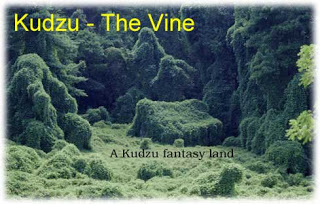 |
During the Depression, the Civilian Conservation Corps got the idea to have unemployed people earn some money by planting kudzu vine in the South to reduce erosion. It seemed like a good idea at the time, but in biology, not all good ideas stay good ideas. Yes, there is a cabin under all that vine. |
Will today?s good idea be tomorrow?s bust? In nature, an adaptation may provide an advantage today, yet be the cause of extinction tomorrow. Conditions rarely remain the same and never duplicate themselves. Very few organisms could develop identically at different times and places ? but lichens are the exception.
Genetic studies of lichens from different places and of different ages show us that these amazing organisms have developed numerous times. This doesn?t mean that different lichens have appeared and gone extinct, only to make a comeback. It means that at least seven times in the history of life on Earth, a fungus and a photobiont (algae or cyanobacteria) have developed the exact same symbiotic relationship that we see in today's lichens.
Each of these original ideas has used different fungus types and sometimes different photobionts, but their relationship is identical in each case. Think of that, lichens are such a good idea that over 4 billion years, in deserts, forests, and coastlines lichens have invented themselves again and again. That must be one good idea!
One reason lichens have been so exceptional is that they can survive in places that can?t support much life. This may be the link in the separate development of lichens time and time again. One reason for their success in desolate environments is that they are veritable chemical factories. They make many products, some of which have uses in their stark homelands. Many of these products are unique to lichens.
Lichen acids (also called lichen substances or lichen products) are chemicals made by the lichen by further processing of regular cellular products, making them secondary metabolites. Lichens make 600-800 of these products, and all but 60-80 of them are unique to lichens.
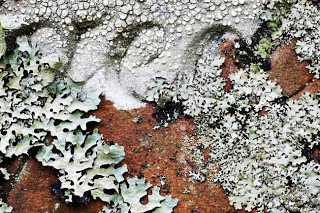 |
The lichens themselves can be different colors, based on their constituents. However, their colors may be hidden under the different lichen products excreted from the cortex onto the thallus. Here the lichen products are white and crystalline, and probably mean that the conditions aren?t great for lichen growth. |
Even more amazing, neither the fungus nor the algae (or cyanobacteria) that make up the lichen produce lichen acids when they are on their own. Many are made by the fungal component of the lichen, but the type of photobiont included in the symbiosis will control which lichen acids can be made. Most are produced as crystalline powders that are deposited extracellularly, on the stalks or the thallus bodies.
Making lichen acids would be wasted energy if they did not confer some advantage to the lichen, and evidence suggests that they do have specific functions. Lichens that are growing rapidly (for them, still might be only 1 mm/year) make very little of these lichen products. When exerting energy to make biomass, the lichen doesn?t need the lichen acids. This suggests that the acids are most needed when the going is tough, when lichens are trying to survive in poor conditions, ie. on difficult substrates, in drought, in extreme temperature or radiation, etc.
What is more, there must be very specific functions for the different acids based on what the lichen needs to do to survive. Lichens of identical morphology and made up of the same component fungus and algae can make very different acids, depending on their location or environment. Lichens can be grouped into complexes of similar organisms, but they may make different lichen acids.
For example, the Ramalina siliquosa complex of lichens is found on the Atlantic coastline of Europe. Low on the cliffs, most exposed to the sun and saltwater, R. cuspidate produces a lichen acid called stictic acid. However, high on the cliffs, away from the wind and facing toward the continent, R. crassa produces lots of hypoprotocetraric acids, but no stictic acid at all. Finally, R. stenoclada lives in the region between the other lichens, and produces a different lichen acid, norstictic acid. These different positions must present different growth challenges, and the lichens respond by making different acids.
So what do these lichen products do for the symbiots? They can dissolve rock to help anchor the lichen, and they can increase membrane permeability to permit flow of carbohydrates from the photobiont to the mycobiont. Many functions have been proposed and demonstrated, and one lichen acid, usnic acid, is a particularly good example of many of these functions.
Usnic acid is a dye that provides many advantages to the lichen, but has also been a traditional dye for yarn for hundreds of years. |
Usnic acid was first described in 1844, and is a yellow-green dye. Its color provides protection for the lichen from damage by visible and UV light, but this is just the beginning. Usnic acid is also important for protection of the lichen from predation. It has anti-herbivore properties, meaning that tastes bad or is toxic to the snails that like to make a meal of lichens. It has the same effect on insects and many fungi and microbes.
Antibacterial properties are particular strong for usnic acid. Many lichen acids are effective against a group of bacteria called Gram+. These include Mycobacterium tuberculae, several streptococci and staphylococci and some pnemuococcus. But a 2011 study indicates that usnic acid can go even further, and is toxic to Helicobacter pylori, the organism responsible for causing many stomach ulcers. Importantly, the usnic acid is not toxic to the photobiont component, whether it be cyanobacteria or algae. In addition, usnic acid has demonstrated anti-inflammatory properties and is a painkiller (analgesic).
But the most promising and surprising activity of lichen acids is as a degrader of prion proteins. Misfolded prion proteins are lethal to humans and other organisms (see -An Infectious Genetic Disease) and are resistant to being broken down by all known human protease enzymes. But a few lichens can produce a protease that destroys prions, some down to the level of undetectability. Fungi themselves are susceptible to prion diseases, so this may be why the lichens produce anti-prion enzymes, but no one has checked lichens for prions. Not enough is known yet to predict if lichen products could be used as treatments for Creutzfeld-Jakob or fatal familial insomnia; here?s your chance to win a Nobel Prize!
This may be an important human use for lichens, but humans have been using lichens for thousands of years. Many of the dyes we use are lichen acid based, as is the litmus dye used in pH paper. Other uses have been more inventive, like as stuffing in Egyptian mummies and in Native American Indian diapers! If these don?t appeal to you, perhaps the Iceland-made lichen schnapps will be more your style. It supposedly tastes a lot like mouthwash.
However, we are amateurs compared to lichens in using the lichen acids. Lichens also use these products to grown on rocks. No soil needed. Crustose lichens are firmly attached to rock surfaces; they can?t be separated without damage?. to the rock.
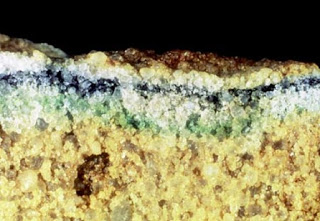 |
Some lichens can protect themselves from poor environments by Living within the rocks. Euendolithic lichens, like the one shown above, bore into the rock using lichen acids, and then grow under the surface of the rock. ?You make a better door than a window,? apparently doesn?t apply to rocks, because the endolithic lichens still get enough light to perform photosynthesis. |
Lichen acids can chemically weather rock by literally dissolving it. This provides crevices for the lichen to attach itself. Lichens can live on top of the rock (epilithic, epi = on top, and lith = stone), or they can be endolithic (within the stone). Within endolithic types, they can be chasmolithic, meaning they limit themselves to the fissures in the rocks and between the mineral grains, or they may be cryptoendolithic, meaning that the lichens grow within natural cavities in the rock. Finally, there is euendolithic lichens, and these are the toughest guys. They can dissolve the rock to the point of boring directly into the rock and creating its own cavities. Interestingly, the lichen will absorb much of the dissolved minerals, up to concentrations that would kill other organisms. This may prevent predation by making the lichen toxic to things that might eat it.
This ability to grow below the surface of a rock is exceptional. The photobiont must still be close enough to the surface to receive sunlight, but growing beneath the surface can protect the lichen from destructive forces of nature. Together with lichen acid protection from UV radiation and the lichens ability to survive extreme temperatures, the ability to grown inside rocks has implications for space travel.
We know that lichens can survive in space (I?m Likin? The Lichen) and growing inside rocks would protect them from re-entry temperatures, so could lichens have arrived on Earth from outer space? Pangenesis is the theory that life on Earth arriving from other planets, and lichens seem like a natural for this process. Unfortunately, pangenesis is most often considered with bacteria alone, and as a theory it has not got much to support it. But it is still an interesting proposition.
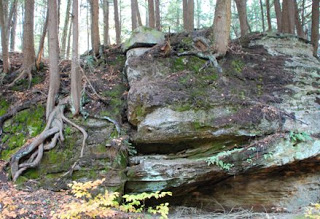 |
This rock is getting a good does of biological weathering. Tree roots, lichens, and probably burrowing animals are all working to reduce this noble boulder to gravel. |
Growing inside rocks and dissolving the rock as needed promotes weathering breaking down of rock). Two type of weathering are brought about by lichen grown. Physical weathering comes primarily from turgor pressure. When the lichen takes up water (when it can get some), it swells and puts pressure on the fissures of the rock. Over time, this will lead to cracks and parts of the rock falling off.
There is also chemical weathering. This comes from the lichen acids dissolving the rock. Some of the minerals are mixed with the bits of rock that break off due to physical weathering and the organic material left over from dead lichens. All together, this makes soil. The process of pedogenesis (soil formation) is an important aspect of lichen growth. Making soil promotes the succession of bigger and more complex life forms, which then continue the weathering and soil formation. Look around you, all that dirt outside your window, deeper than you could dig, is there because of lichens started it all off ? amazing. Lichens could be the most important player when it comes to human terraforming (terra = Earth and form = make like) another planet for future colonization.
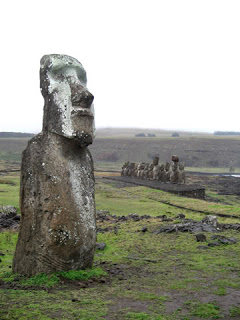 |
Lichen growth on Easter Island. This ancient statues can?t survive much Moai! |
Not everything about weathering rock by lichens is good; consider their effects on stone statues. Some people say that the covering is protective, keeping the wind and sun from damaging the statue, but other say the chemical weathering promotes their breakdown. At Mount Rushmore, workers actively scrub the mountain to remove lichens and prevent the aging of Presidents Lincoln, Roosevelt, Jefferson, and Truman. How would you like to have that job, hanging off a cliff scrubbing out Theodore Roosevelt?s huge nostrils?
There is a strange dichotomy with lichens. They have arisen many times. They live thousands of years. They live in space, surviving radiation, extreme temperatures, and dryness. But lichens are very susceptible to pollution, it kills them or stops their growth. Lichens have billions of years of success behind them, but it took humans to find a way to kill them off. As such, we now use lichens as indicator species, to determine if pollution concentrations are affecting nature. They built our world, now maybe they can help us to save it.
Heng Luo, Yoshikazu Yamamoto, Hae-Sook Jeon, Yan Peng Liu, Jae Sung Jung, Young Jin Koh and Jae-Seoun Hur (2011). Production of Anti-Helicobacter pylori metabolite by the lichen-Forming fungus Nephromopsis pallescens Journal of Microiology DOI: 10.1007/s12275-011-0289-9
For more information on lichen products, biological weathering, or pedogenesis, see:
Lichen acids ?
http://www.gaiachem.com/lichen.html
http://lichens.science.oregonstate.edu/antibiotics/lichen_antibiotics.htm
http://www.countrysideinfo.co.uk/fungi/lichens.htm
www.uni-graz.at/~grubem/treasure.pdf
www.ars.usda.gov/is/ar/archive/jan01/lichen0101.pdf
http://www.thebls.org.uk/content/chemical.html
Biological weathering ?
http://www.geography4kids.com/files/land_weathering.html
http://www.lad.wur.nl/UK/Research/LAPSUS/Modules/Biological/
http://www.geolsoc.org.uk/gsl/pid/3568;jsessionid=8C3F5253340E02BEDE9FE9C0234D4A0D
http://mc2.vicnet.net.au/home/conserv/web/biolog.html
http://www.soils.wisc.edu/courses/SS325/weathering.htm#stages
http://www.pbs.org/wnet/nature/lessons/breaking-it-down/activities/1700/
http://alex.state.al.us/lesson_view.php?id=24146
http://www.okaloosa.k12.fl.us/technology/WOWLessons/WaltsYouveBeenWeathered.htm
http://ethemes.missouri.edu/themes/1318
Pedogenesis ?
http://www.physicalgeography.net/fundamentals/10u.html
http://www.anbg.gov.au/lichen/ecology.html
http://www.wormdigest.org/content/view/222/2/
http://www.eoearth.org/article/Soil
files.dnr.state.mn.us/education.../activities/.../lichens_studyguide.pdf
http://www.concord.org/~btinker/gaiamatters/investigations/lichens/classactivities.html
- Angiocarpous
Term: angiocarpousLiterally meaning: ?fruit in vessel?Origin: Anc Greek??????/aggio (=vessel, receptacle) > ?????/aggos(=tube)??????/carpos(=fruit, grain)Coined/History(?)DefinitionAngiocapous is the fruit partially or wholly enclosed in a shell,...
- Thallus
Term: thallus (pl thalli) Origin: Anc Greek ??????/thallos(=young shoot) > ?????/threpho(=feed)Definition:Thallus is the undifferentiated tissue of some algae, fungus, and other lower organisms as liverworts and lichens which are not organized...
- The Living Earth ? Rocks And All
Biology concepts ? Gaia Hypothesis, photosynthesis, biogeology, plate tectonics, biological weathering, oxygen crisis The physical form of Earth definitely influences how life evolves on Earth. You can't argue that ice ages and the birth of shallow...
- I?m Likin? The Lichen
Biology Concepts ? symbiosis, mutualism, lichens The lycan is a subject better relegated a cryptozoology blog. Along with the Loch Ness Monster, vampires, and the Easter Bunny, cryptids are those animals for whom there is little or no solid evidence,...
- Structure Of Living Beings.
Differentiation between living beings and inert matter is an easy question, at least in appearance. This is, however, because we usually think about living things that can be clearly seen growing, moving or, summing up, changing. But if we take...
